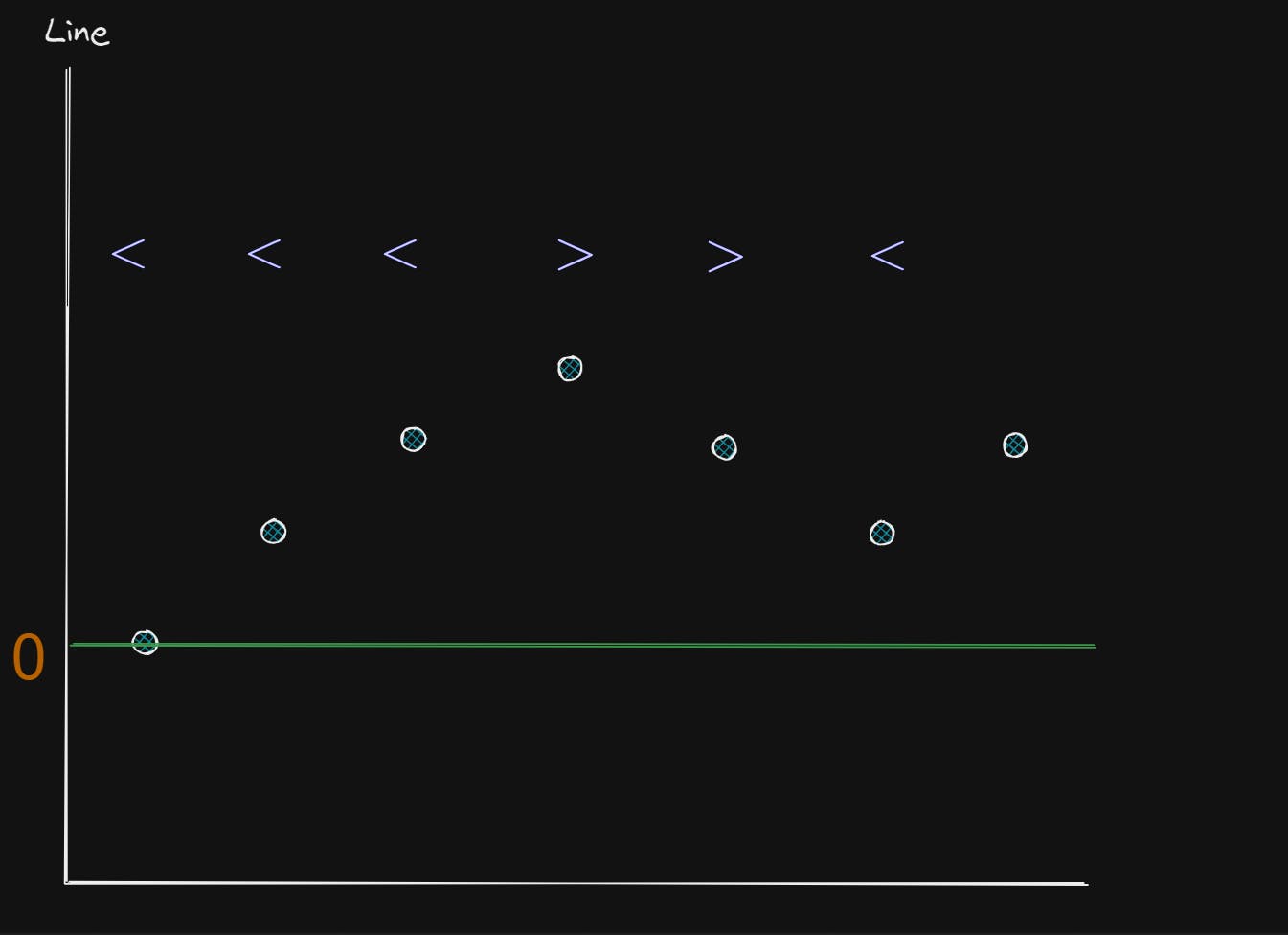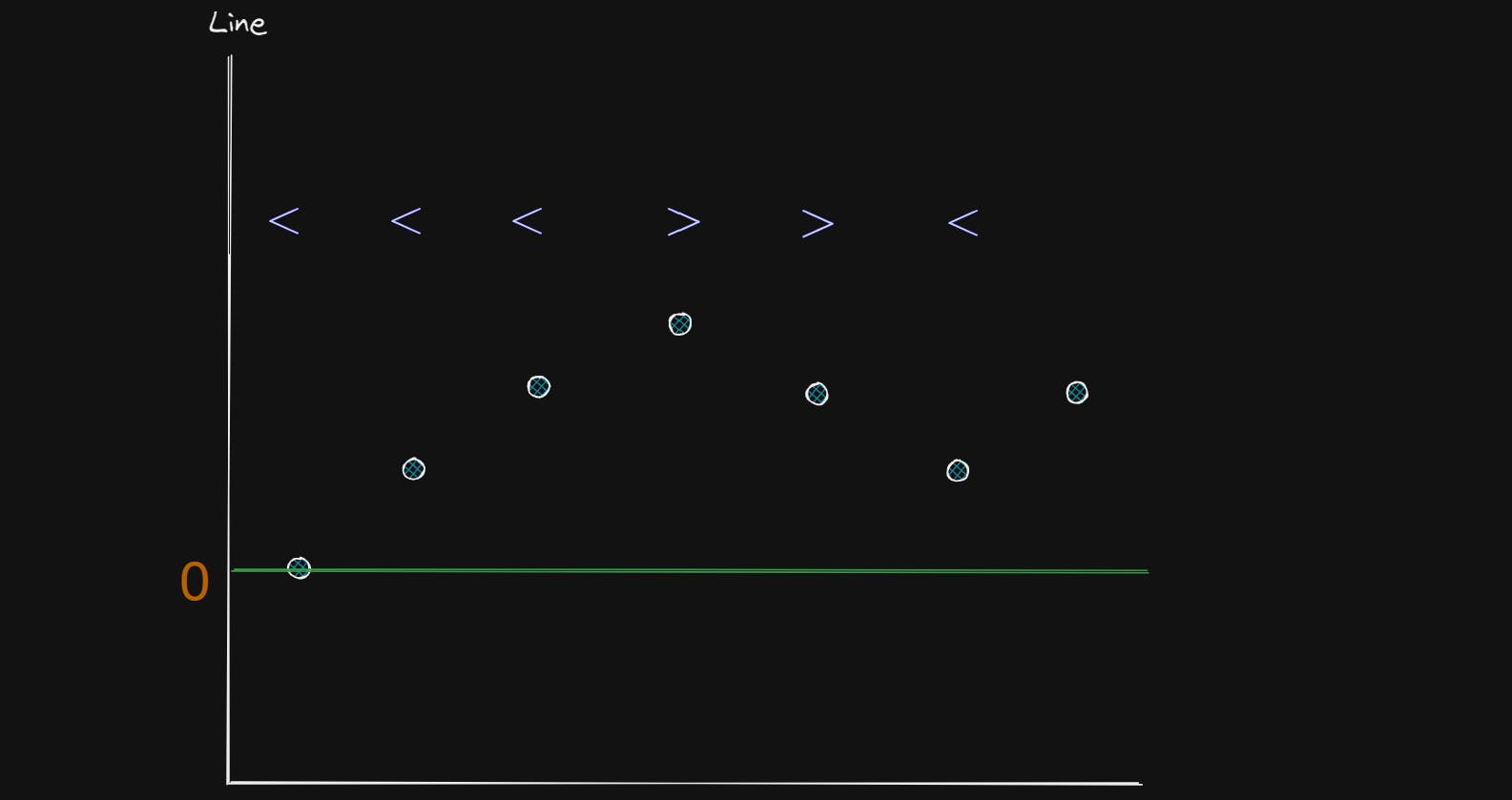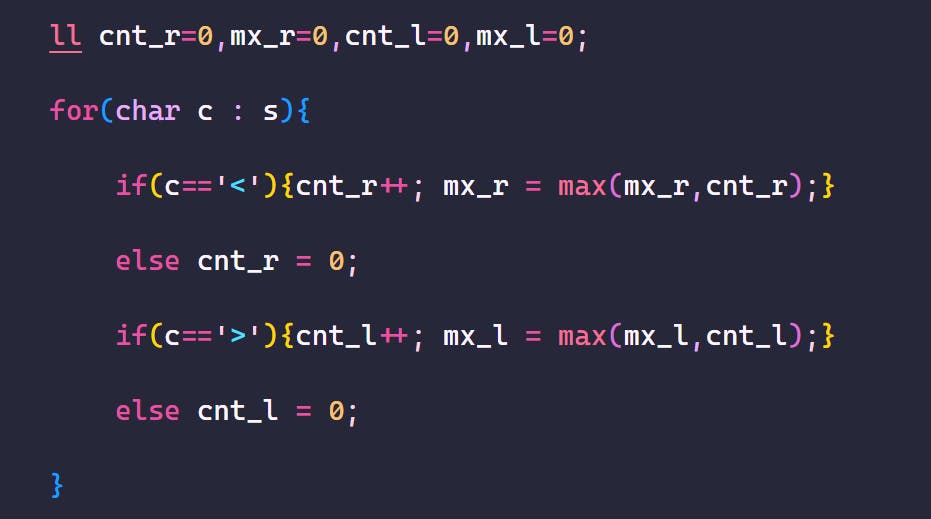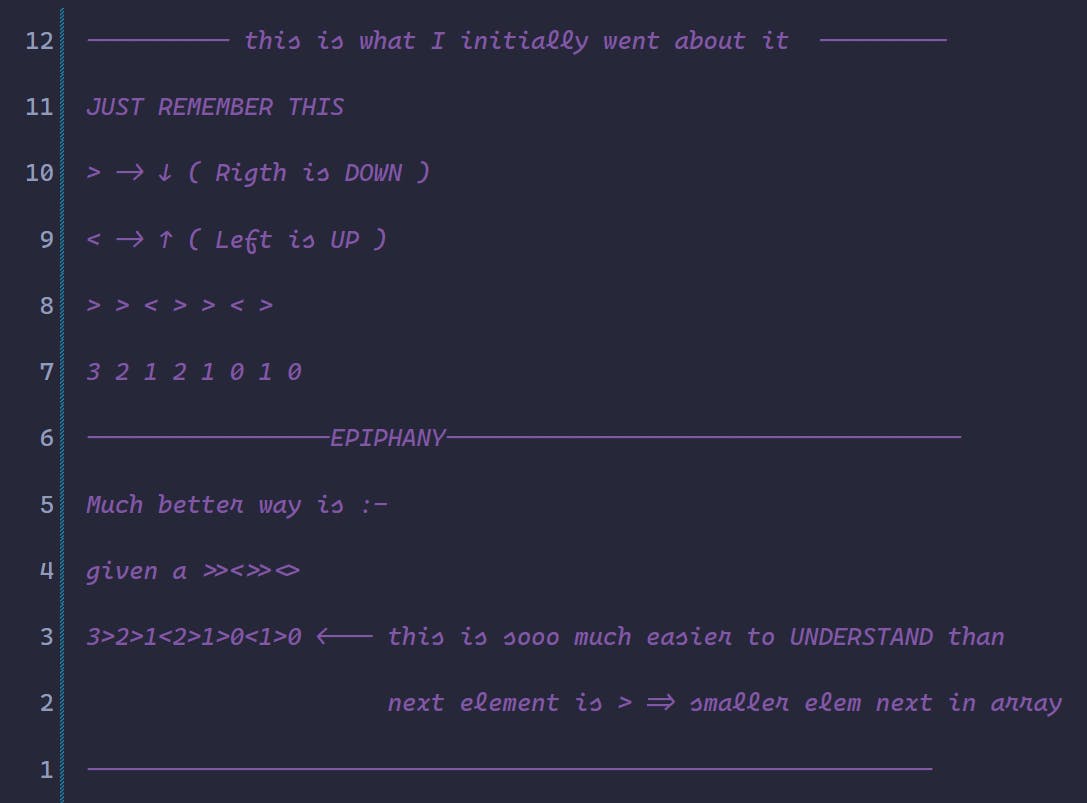Table of contents
- Question
- Algorithm I came up with
- Visualization of this Algorithm
- Code Implementing this Algorithm
- The Edge case that I didn't understand
- Correct Solution to the Edge Case
- Fundamental problem with my algorithm - What I got Logically Wrong
- Correct Algorithm - it's just Greedy Lol !
- Code Implementation
- Learnt a new trick !
- 2 Important lessons
Question
Problem Statement

Input and Output Formats

Time and Space constrains

Sample Test Cases
Input
4
4
<<>>
4
>><<
5
>>>>>
7
<><><><
Output
3
3
6
2
Algorithm I came up with
Idea
We just have to simulate a stack ;
One idea is to start from 0, whenever we see >, we push to the stack, when we see <, we pop from the stack.
A better phrasing would be to change a variable initially set to 0, according to the same rules - add 1 if you see '<' otherwise subtract 1.
I had learnt a trick recently in C++ :-
c += (ch=='<') 1 ? : -1 ;
In one line, we can capture the entire algorithm.
Answer
So total number of distinct elements would be :-
- The maximum up the stack can go + The minimum level to which stack can go + 1
Or :-
- max(c) + | min(c) | + 1
Visualization of this Algorithm


Note :
the points should be allowed to go below 0 too
the stack should be allowed to grow below 0 too
Code Implementing this Algorithm
void wrong_ans(){
ll t,n; string s;cin >> t;
while(t--){
cin >> n >> s;
ll c=0,mx=0,mn=0;
for(char ch : s){
c += (ch=='>') -1 ? : 1 ; // cool trick, huh ?
mx = max(c,mx) ;
mn = min(c,mn) ;
}
cout << mx + abs(mn) + 1 << "\n" ;
}
}
The Edge case that I didn't understand
>><>><>
I thought the compatible array would be something like :-
3 2 1 2 1 0 1 0
or if you start with 2 :-
2 1 0 1 0 -1 0 -1
At this point I also had the simple but really useful epiphany of writing this as :-
3 > 2 > 1 < 2 > 1 > 0 < 1 > 0
2 > 1 > 0 < 1 > 0 > -1 < 0 > -1
So I thought we needed 4 distinct numbers as did my algorithm also predict but the correct answer was 3 - this meant a very huge problem :-
MY ALGORITHM ITSELF WAS LOGICALLY WRONG :(
Correct Solution to the Edge Case
I focused on just this one test case for a long time and it finally clicked :-
3 > 2 > 1 < /*3*/ > 2 > 1 < 2 > 1
2 > 1 > 0 < /*2*/ > 1 > 0 < 1 > 0
The commented number is where I went wrong.
Fundamental problem with my algorithm - What I got Logically Wrong

This idea that NEXT ELEMENT OF ARRAY is always 1 off from current element was the fundamental flawed.
Let me Explain :-
For the test case
> > < > > < >
3 > 2 > 1 < /*2*/ > 1 > 0 < 1 > 0 // <--- what I thought
Notice that after 1, I PICKED 2 ;
BUT I COULD HAVE PICKED 3 !!
Correct Algorithm - it's just Greedy Lol !
The correct way to think about this approach is very different from what I initially came up with :-
Thought Process :-
Suppose there is a segment of length k that consists of equal characters in s. This segment implies that there are at least k + 1 distinct values in the answer.
So, the answer is at least m + 1, where m is the length of the longest segment of the string that consists of equal characters.
Can we construct the array a which will contain exactly m + 1 distinct values?
It turns out we can do it with the following greedy algorithm :-
Use integers from 0 to m for our compatible array.
Construct it from left to right;
every time we place an element,
we choose either the largest possible integer we can use (if the next character is >)
OR
the smallest possible integer we can use ( if the next character is <).
So, the problem basically reduces to finding the longest contiguous subsegment of equal characters in s.
Code Implementation
void solve(){
ll t,n; string s;cin >> t;
while(t--){
cin >> n >> s;
ll cnt_r=0,mx_r=0,cnt_l=0,mx_l=0;
for(char c : s){
if(c=='<'){cnt_r++; mx_r = max(mx_r,cnt_r);}
else cnt_r = 0;
if(c=='>'){cnt_l++; mx_l = max(mx_l,cnt_l);}
else cnt_l = 0;
}
cout << max(mx_l,mx_r) + 1 << "\n" ;
}
}
Learnt a new trick !

This is how I implemented the logic, which I thought was pretty clean and tiddy.
2 Important lessons
Easy way to think about the array I could construct
The epiphany to write it neatly like :-
3 > 2 > 1 < 2 > 1 > 0 < 1 > 0
Before I had to struggle a bit :-
> > < > > < > 3 2 1 2 1 0 1 0

These are small but really important approaches that gives me much better way to model the stuff I see.
How to find the longest contiguous substring of same character
when it's just 1s and 0s or as given here >s and <s
what happens if it can be anything ? Hashmap ? Nah
// cnt stores the LENGTH of the longest contiguous substring int cnt = 1, now = 1; for(int i = 1; i < n; i++) { if(s[i] != s[i - 1]) now = 1; // new elem is diff from last elem else now++; cnt = max(cnt, now); } cout << cnt + 1 << endl;
Often times when you are given an array, Comparison string gives a the only necessary information we need about the array.
No conclusion section today, this problem just hurt my ego - I need to have a better mindset with these things, sigh.
Thank you,
__CPP_Try_Hard__ ;
